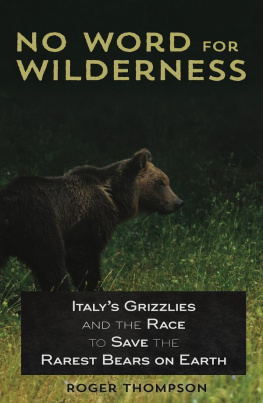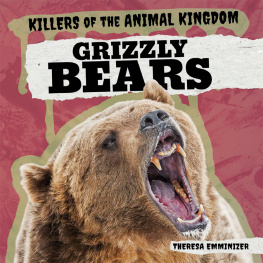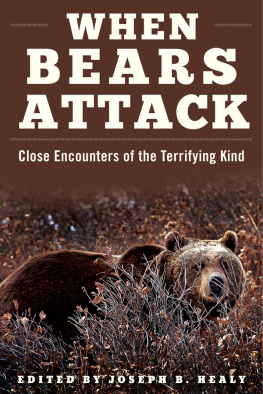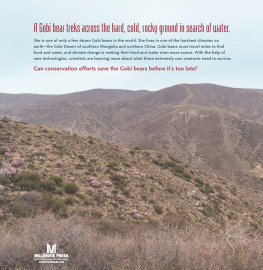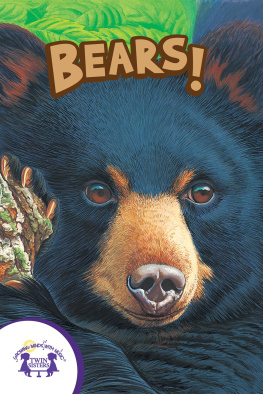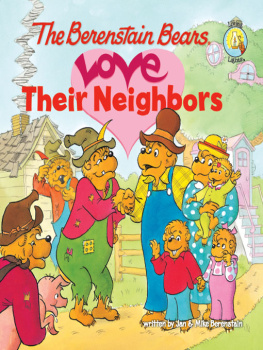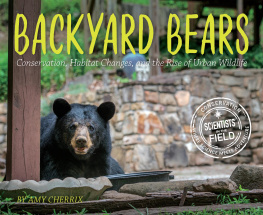All rights reserved. No part of this book may be reproduced or transmitted, in any form or by any means, without written permission of the publisher.
Introduction:
Banff and Reno
Not far from the blue waters of Lake Louise, we descended into a small meadow. I was hiking in Banff National Park with Reno Sommerhalder, a proud native of Switzerland who is an internationally recognized bear naturalist. A thoughtful, meditative, and persistent advocate for bears around the globe, he lectures on them frequently throughout Europe and has published well-received memoirs about his life among grizzlies. I knew taking a long walk with him in the Canadian Rockies in search of bears was bound to be an adventure.
We were only an hour or so into our hike when we decided to head off-trail to seek out the bears. Ahead of us was Mount Assiniboine Provincial Park, and the backcountry between it and the more popular areas of Banff promised ideal habitat for bears. Just before we turned west toward the border of British Columbia, however, a young woman emerged from behind a ridge and walked our way. When she was only a few meters away, she hailed us.
Hello, she said. Its a perfect day!
She was right. The day had started with some cold, early morning mist, but the skies had cleared, and a bright sun was shining, warming us from an autumn breeze that was flowing down from nearby peaks. Snow had already fallen in higher elevations, and that night, it would dust our tent as well, but now, midmorning in the fullness of the rich, sunny air, it seemed like a perfect day.
The young woman who called out to us was Vladmira Lackova, an outdoor enthusiast who has worked around the world in various nature parks. She is a native of Slovakia, and her Facebook feed looks like an adventure travel website. A savvy and experienced world traveler, she has set foot in more remote places than most of us could ever hope. That day, high in an alpine meadow in the shadow of Assiniboine, she would unwittingly change my life.
Vladmira told me that bears lived in Italy, an idea I found so disorienting that I expressed not just surprise but outright skepticism. She was, however, insistent. Not only are there bears in Italy, she said, but they are brown bears. She saw my incredulity and leaned toward me, cast her eyes around as though sharing a secret, and said with a mocking fake whisper something that to my mind made her claim cross into the realm of genuine absurdity.
They live, she said, barely an hours drive from Rome.
I looked at Reno. Vladmira looked at Reno. I searched for some sign of a joketwo Euro-somethings playing tricks on the American in the Canadian Rockiesbut it never came. Instead, there was only Vladmiras final assertion.
They are, she insisted, very, very special bears.
Reno echoed the sentiment, and I realized that he, too, knew about Italys bears. Indeed, he knew them quite well. A wilderness guide, he leads bear observation trips around the globe and has been deeply involved in European bear campaigns. He ushers adventurers to Alaska, and he is one of the few people Russian officials permit to lead trips into Kamchatka to see the remarkable bears there. If youre an American, hes your only ticket to that part of the world. He is as conversant with bear conservation issues and as knowledgeable of different bear populations as anyone on Earth, so Vladmiras story about Italian bears was no surprise to him. He suggested it should not be to me either.
I did not know how to make sense of it. Brown bears were the stuff of remote wilderness and high mountains. How could they live so close to Rome? Yet they do, and they have for longer than any written record that exists. The history of Rome means absolutely nothing to them, and neither does their proximity to so many millions of people.
There are, of course, bears within an hours drive of other major metropolitan areas around the world. Within an hour of Calgary or Denver you can find bears, and, if youre clever enough to know where to look, you might find them a short drive from San Francisco or LA. Certainly, not far from Seattle and Portland you can find bears aplenty. But outside of Rome seemed impossible to me. In some ways, it still does. Despite years of outdoor guiding and education, I had never heard about bears in Italy.
As it turns out, I am not alone. Anyone I have spoken to after that day in the Rockies seems as surprised as I was, and equally incredulous.
Black bears? many of them ask.
No, brown bears, I say, usually following this with an anticipatory rebuttal: Im not joking.
Doubt is warranted, I think. We associate Italy with ancient history, Tuscan landscapes, great wine and food, astonishing art, religious and spiritual traditions, fierce pride in local customs, and any number of stereotypes about the people who now call themselves Italian Americans, but few of us conjure images of natureat least in the sense of wilderness and the wildwhen we think of Italy. The land is too old there, too saturated with human civilization, and too long developed by human industry and culture.
But brown bears persist there. Against all odds and in contradiction to what most of us think we know about human-animal interaction, they have found a way to survive in the face of one of humanitys oldest societies.
The journey to my understanding of this startling fact has been, predictably in hindsight, hardly straightforward, and this book is an attempt to try to suss it all out. My hope is that this book provides some sense of the history of the bears there while tracing in as clear a way as possible the complicated relationships between humans and animals in that part of the world. As a forestiero , the term some Italians use to label an outsider or even interloper, I recognize significant limitations to what I might accomplish. My ability to penetrate the richness and nuance of the Italian experience, let alone the extensive scientific work being done on behalf of the bears, is certainly worthy of some skepticism in its own right. To try to compensate, I relied throughout this project on the goodwill and genuine devotion of too many people to count. While stories shifted and changed as different people told me about their lives with the bears, it was rare that one story contradicted or undermined the truth of the incredibly complex issues surrounding conservation in Italy. Their different stories were like the various colors a prism casts, none outshining the other but each sparking from a central, crystalline truth, which is this: The bears in Italy need help.
It turns out that there is more than one population of brown bears in Italy, and understanding the distinction between the twoone the last vestige of a former time that persists against all odds and the other a great experiment in rewilding that, if successful, promises to change how we see not only Italy but all of Europeis one of the aims of this book. To understand that distinction is to face difficult questions about the possibility for relocating wild, large mammals in places like Europe. It is also, however, to encounter promising opportunities for reshaping natural environments all over the world. Italy provides a compelling case study that has been a millennium in the making, and there are surely few comparable experiments in beast-human cohabitation to Italys with bears. If we can make sense of that example and if we can generalize to even the slightest degree what Italys bears can teach us, we will be equipped to carry out fundamental changes in how humans and animals interact and live together.

